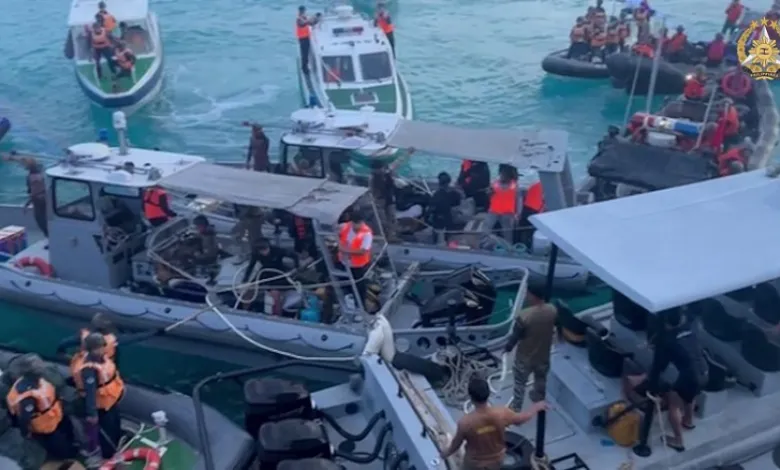By Staff Reporter
The Philippines has accused China’s Coast Guard of launching a “brutal assault” with bladed weapons during a South China Sea clash earlier this week, a major escalation in a festering dispute that threatens to drag the United States into another global conflict.
Footage released by the Philippine military on Thursday showed Chinese coast guard officers brandishing an axe and other bladed or pointed tools at the Filipino soldiers and slashing their rubber boat, in what Manila called “a brazen act of aggression.”
The Philippines and China have blamed each other for the confrontation near the Second Thomas Shoal in the contested Spratly Islands on Monday, which took place during a Philippine mission to resupply its soldiers stationed on a beached World War II-era warship that asserts Manila’s territorial claims over the atoll.
The incident is the latest in a series of increasingly fraught confrontations in the resource-rich and strategically important waterway.
But the scenes captured in the latest footage mark an inflection point in the long-simmering tensions, with China adopting new, far more openly aggressive tactics that, analysts say, appear calculated to test how the Philippines and its key defense ally – the United States – will respond.
China claims “indisputable sovereignty” over almost all of the South China Sea, and most of the islands and sandbars within it, including many features that are hundreds of miles from mainland China. Multiple governments, including Manila, hold competing claims.
Collin Koh, research fellow at the S. Rajaratnam School of International Studies in Singapore, said it was unprecedented for China’s maritime law enforcement to board a Philippine naval vessel.
“They can be rubber boats, but it doesn’t change the fact that they are Philippine Navy vessels, and according to international law, they enjoy what we term as sovereign immunity,” Koh said. “That is very dangerous, because, if anything, that could even be construed as an act of war.”
At a news conference on Wednesday, senior Philippine military officials said China’s Coast Guard officers “illegally boarded” the Philippine rubber boats, “looted” seven disassembled rifles stored in gun cases, “destroyed” outboard motor, communication and navigation equipment and took the personal cellphones of Filipino personnel.
“They deliberately punctured our rubber boats using knives and other pointed tools,” said Alfonso Torres Jr., commander of the Armed Forces of the Philippines (AFP) Western Command.
A Philippine Navy serviceman on the rubber boat lost his right thumb when the Chinese Coast Guard rammed it, Torres said.
China’s Coast Guard also deployed tear gas, “blinding” strobe lights and continuously blared sirens, the AFP said.
“Only pirates do this. Only pirates board, steal, and destroy ships, equipment, and belongings,” Gen. Romeo Brawner Jr, Chief of Staff of the Armed Forces of the Philippines, said in a statement.
“The Chinese Coast Guard personnel had bladed weapons and our personnel fought with bare hands. That is what’s important. We were outnumbered and their weapons were unexpected but our personnel fought with everything that they had,” Brawner added.
At a regular briefing with reporters on Thursday, China’s Foreign Ministry was asked to comment on the allegations from the Philippines that their vessels were damaged by Chinese coast guard personnel wielding blades and firing tear gas.
Spokesman Lin Jian did not address those allegations, and instead reasserted Beijing’s claims over the Second Thomas Shoal, known as Ren’ai Jiao in China.
“The Philippine operation was not for humanitarian supplies at all. The Philippine vessels carried not only construction materials but also smuggled weapons. They also intentionally rammed into Chinese vessels and splashed water and threw things on Chinese law-enforcement personnel,” Lin said. “These actions have obviously aggravated tensions at sea and seriously threatened the safety of Chinese personnel and ships.”
This handout photograph from the Philippine military shows destroyed windshields on a Philippine navy boat.
What happens in the South China Sea has profound implications for the US, which has a mutual defense treaty with the Philippines that dates back decades.
The latest clash marks the first run-in between the two countries since a new law in China took effect Saturday to authorize its coast guard to seize foreign ships and detain crews suspected of trespassing for up to 60 days without trial.
It also comes just weeks after Philippine President Ferdinand “Bongbong” Marcos Jr. warned that the death of any Filipino citizen at the hands of another country in the waterway would be “very close” to an act of war.
Marcos has sought closer ties with the US, which has repeatedly stressed Washington’s “ironclad commitment” to a 1951 mutual defense treaty between the US and the Philippines that stipulates both sides would help defend each other if either were attacked by a third party.
US blasts ‘aggressive’ China over South China Sea collision with Philippine ship
US State Department spokesman Matthew Miller said Monday the “United States stands with its ally the Philippines and condemns the escalatory and irresponsible actions” by China.
In a phone call with his Philippine counterpart Enrique A. Manalo on Wednesday, US Secretary of State Antony Blinken said China’s actions, “undermine regional peace and stability and underscored the United States’ ironclad commitments to the Philippines under our Mutual Defense Treaty.”
Derek Grossman, a senior defense analyst at the RAND Corporation, a US-based think tank, said the footage released by the Philippines “clearly shows a Chinese attack on Philippine military assets,” which according to Washington and Manila’s defense pact would trigger mutual defense commitments.
“However, in practical terms, the Philippines itself would have to initiate a move to activate (it) before the US would intervene militarily,” he said.
In 2016, an international tribunal in The Hague ruled in favor of the Philippines’ claims in a landmark maritime dispute, which concluded that China has no legal basis to assert historic rights to the bulk of the South China Sea.
But Beijing has ignored the ruling. Instead it has increasingly pushed its maritime territorial claims, with China Coast Guard ships – reinforced by militia boats – involved in multiple clashes over the past year that have damaged Philippine ships and seen Filipino sailors injured by water cannon.
Philippine ‘restraint’
The decision by China’s Coast Guard to use bladed weapons in the latest South China Sea clash has drawn comparisons with clashes between China and India on their disputed Himalayan border, where soldiers on both sides have fought fiercely with sticks, rocks and their hands.
The Philippine personnel on the rubber boats are elite forces hailing from the Navy Special Operations Group, Koh said.
“They are trained in combat. They did not retaliate against the Chinese because they’re just simply exercising restraint,” he said. “They probably have received instructions right from the top that under whatever circumstance they are not supposed to fight back against the Chinese and escalate the situation.”
The footage released by the Philippine military also showed another striking development – that the clash took place right next to the BRP Sierra Madre, a rusting US-built Philippine Navy landing craft that was run aground deliberately in 1999, with a national flag hoisted on board, to assert Manila’s territorial claims over Second Thomas Shoal.
This is the closest China’s Coast Guard has come to the BRP Sierra Madre, Koh noted.
“Under normal rules of engagement, the garrison would have fired warning shots,” he said. “The fact that this incident didn’t escalate further is because the Philippines exercised utmost restraint. That’s a simple fact.”
China, Koh said, was trying to test both Manila and Washington “to find out exactly where the red line is.”
“They wanted to see how far the US is willing to pledge its security commitment to the Filipinos. And of course, I don’t think Beijing is dumb enough not to have considered the possibility of having all these actions escalate the situation, but I believe that was a risk that they, in the end, decided to take.”
This story has been updated with additional developments. CNN’s Manveena Suri contributed reporting.


